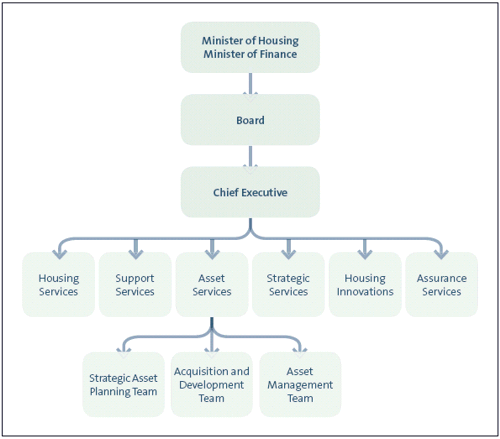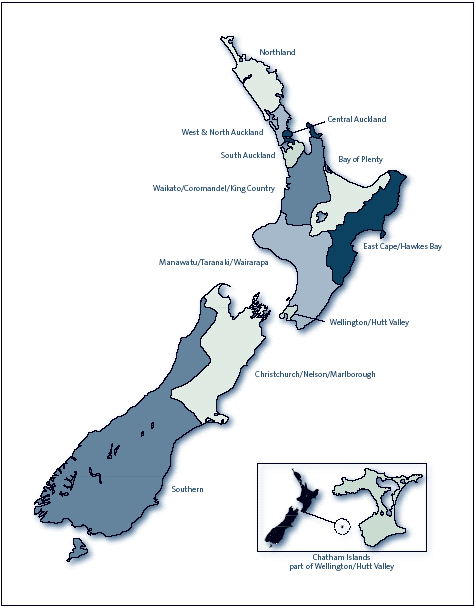Part 1: Introduction
1.1
In this Part, we describe:
- the role and structure of Housing New Zealand Corporation;
- why we audited the programmes for buying and leasing houses;
- our audit objective and performance expectations;
- how we carried out our audit; and
- programmes outside the scope of our audit.
Role and structure of Housing New Zealand Corporation
1.2
Housing New Zealand Corporation (the Corporation) is the entity responsible for
managing state housing on behalf of the Crown.1 It provides housing2 to people
who are unable to find suitable and sustainable accommodation through the
private sector. It houses about 190,000 people, and controls an asset portfolio of
more than 66,000 state houses with a value of $11,300 million. The Corporation
also works to increase levels of home ownership, and has a lead role in advising
the Government on housing policy.
1.3
The Corporation’s services are in high demand. As at 30 June 2005, there were
11,458 applicants on the state housing waiting list. Of these applicants, the
Corporation assessed 4288 as being of high priority for state-provided housing. Although 57% of the high-priority applicants live in Auckland, only 44% of all state
houses are located in Auckland. In response to this demand, the Corporation plans
to increase the number of state houses by 3164 between 2005-06 and 2008-09. Most of the additional state houses will be in Auckland.
1.4
Some of the additional houses will be built by the Corporation, and some will
be buildings bought or leased from private owners. The Corporation will also
reconfigure some houses to make them better match the needs of applicants on
its waiting list. Most state houses are made available to applicants on the general
waiting list, but some are specifically for people in rural areas, and some are made
available only to providers of residential services to people with special health or
welfare needs.
1.5
The Corporation was formed in 2001 by the merger of 4 agencies that had
separately overseen different aspects of state housing and housing policy.3 It is governed by a Board of 8 members and is accountable to both the Minister of
Housing and the Minister of Finance. The Minister of Housing has the primary
relationship with the Corporation, while the Minister of Finance oversees the
Corporation’s borrowing.
1.6
The Corporation has adopted the New Zealand Housing Strategy’s vision as
the overarching outcome towards which it works.4 The overarching outcome is
that “All New Zealanders have access to affordable, sustainable, good quality
housing appropriate to their needs.” The Corporation has identified 3 outcomes
that contribute to the overarching outcome. They illustrate the importance the
Corporation places on taking into account the needs of the users when addressing
housing needs –
- New Zealanders in the greatest housing need receive appropriate assistance and support
- the social housing sector is effectively supported to deliver affordable, sustainable, good quality homes
- the wider housing sector is effectively supported to provide appropriate housing.5
Structure of Housing New Zealand Corporation
1.7
The Corporation is organised into 6 business groups. Each business group is led
by a general manager. The Asset Services business group’s responsibilities include
planning for, and acquiring, more state houses. Separate teams oversee these
different processes. The teams and their place in the Corporation’s structure are
shown in Figure 1.
Figure 1
Housing New Zealand Corporation's structure

Source: Adapted from Housing New Zealand Corporation (2005), Statement of Intent 2005–2008, page 20.
1.8
The Corporation uses a regional structure to deliver services to the public. There
are 11 regions, each administered by a regional manager. There are 3 regions
within Auckland. Staff from the Corporation’s business groups work together
within each region. Corporate management and support is provided to the 11
regions by offices in Manukau City, Wellington, and Christchurch.
1.9
The staff responsible for managing tenants and properties are based in 43
neighbourhood offices spread throughout the 11 regions. Each neighbourhood
office focuses on a particular geographic area. However, specific housing needs
might vary within each area. For example, the Glen Innes neighbourhood office
in Auckland manages properties in the suburb of Glen Innes, which has relatively
high levels of deprivation, but also manages a few properties in more affluent
areas such as Mission Bay and Waiheke Island.
1.10
The Corporation’s 11 regions for delivering services are shown in Figure 2.
Figure 2
Housing New Zealand Corporation's 11 regions

Why we audited the programmes for buying and leasing houses
1.11
In 2001-02, the newly formed Corporation began a major programme of capital
spending on state houses. As part of this, the Corporation has steadily increased
the number of state houses throughout the country. It has received additional
capital appropriations in 2004-05 and 2005-06, totalling $256.6 million, to
address high housing need, particularly in Auckland.
1.12
Given that the Corporation plans to provide 3164 additional state houses between
2005-06 and 2008-09, an audit of the programmes used to acquire properties
is timely. We selected the buying and leasing programmes for the audit as they
will be used to acquire over half of the additional properties. The Corporation will be acquiring 650 new properties through the buying and leasing programmes
in 2005-06. This is 63.8% of the 1019 new properties the Corporation plans to
provide in 2005-06.6
Our audit objective and performance expectations
1.13
The objective of our audit was to provide assurance to Parliament about the
effectiveness of the Corporation’s buying and leasing programmes for providing
state housing.
1.14
We expected the Corporation’s planning for buying and leasing properties from
private owners to be robust, and to provide state houses of the required standard
to people in need of them.
1.15
We expected the 2 programmes we audited to be linked to the Corporation’s
business goals through a wider strategy, and that there would be plans for
achieving the targets for each programme.
1.16
For each programme, we expected:
- purchases or leases to be made in keeping with the Corporation’s policies and procedures;
- standards for financial performance and quality to be met;
- the most suitable properties to have been obtained; and
- newly acquired properties to be made available to high-priority applicants without delay.
1.17
We also expected the Corporation to be monitoring, and periodically evaluating,
the performance of its buying and leasing programmes.
How we carried out our audit
1.18
To assess the planning framework, we interviewed staff responsible for asset
planning and asset management, and examined important strategies and
planning documents.
1.19
We interviewed managers and staff responsible for buying and leasing properties. We reviewed 48 acquisition files to see whether they complied with the relevant
policies and procedures.7
1.20
We discussed with regional managers the process of making newly acquired
properties available to tenants. We reviewed electronic records for 126 properties
that related to the 48 acquisition files we reviewed, to see whether there were
delays between when properties were available to be tenanted and when they
became occupied.
1.21
We reviewed the monitoring and reporting systems that related to buying and
leasing, and met with the Corporation’s internal auditors to learn about the
Corporation’s risk management framework and its oversight of the 2 programmes.
Programmes outside the scope of our audit
1.22
We did not review the Corporation’s programmes that are aimed specifically at
rural housing and residential services for people with special health or welfare
needs. However, our examination of the strategies, plans, monitoring, and
reporting for leased and bought properties has provided us with a good overview
of the systems that the Corporation uses for acquiring state houses in general.
1.23
We did not directly examine the Corporation’s building or redevelopment
programmes. We did not examine the Corporation’s significant building activities
nor the planned large development at Hobsonville, West Auckland, that is
expected to provide 3000 new homes (of which 600 will be retained as state
houses). However, we will continue to assess whether we need to review the
Corporation’s building and development activities.
1: Housing New Zealand Corporation is a Crown entity established under the Housing Corporation Act 1974, as amended by the Housing Corporation Amendment Act 2001.
2: In this report, “property”, “state house”, and “house” refer to all types of housing, including stand-alone houses, townhouse units, and units in blocks of flats.
3: The 4 agencies were Housing New Zealand Limited, responsible for managing state houses at market rent; Housing Corporation of New Zealand, responsible for managing the loan portfolio; Community Housing Limited, responsible for managing the community housing portfolio; and the Housing Policy Team from the Ministry of Social Policy, responsible for providing housing policy advice.
4: The New Zealand Housing Strategy was launched in May 2005 after consultation, research, and analysis that involved local government, communities, businesses, and central government agencies. The New Zealand Housing Strategy sets priorities for housing and an action plan for the housing sector as a whole.
5: Housing New Zealand Corporation (2005), Statement of Intent 2005–2008, page 11.
6: Housing New Zealand Corporation (2005), Statement of Intent 2005–2008, page 30. Of these 650 new properties, the Corporation plans to buy 216 properties, enter into 350 new leases with private owners, and renew 84 existing leases.
7: We reviewed 23 lease files and 21 purchase files. We also looked at 4 files for proposed acquisitions that had been cancelled part-way through the process. The files related to single houses, several houses leased or purchased at once, multiple-unit buildings, and apartment complexes. In total, the 48 files covered 133 individual properties.
page top
